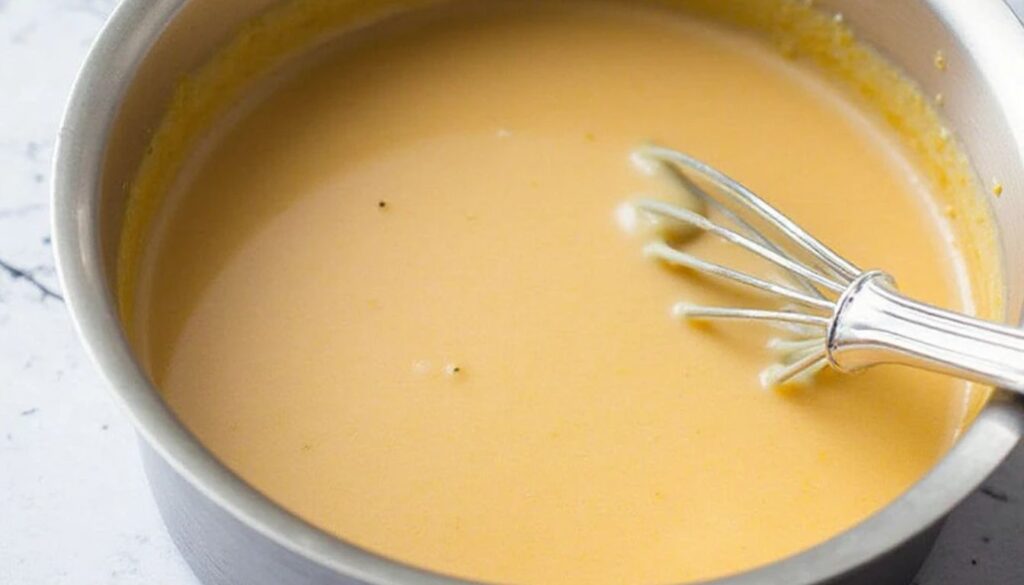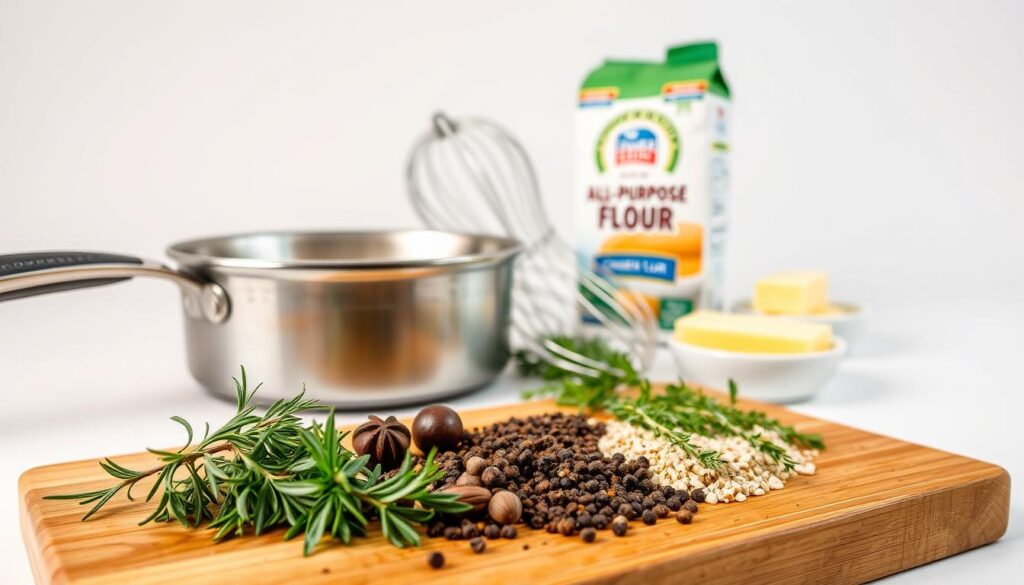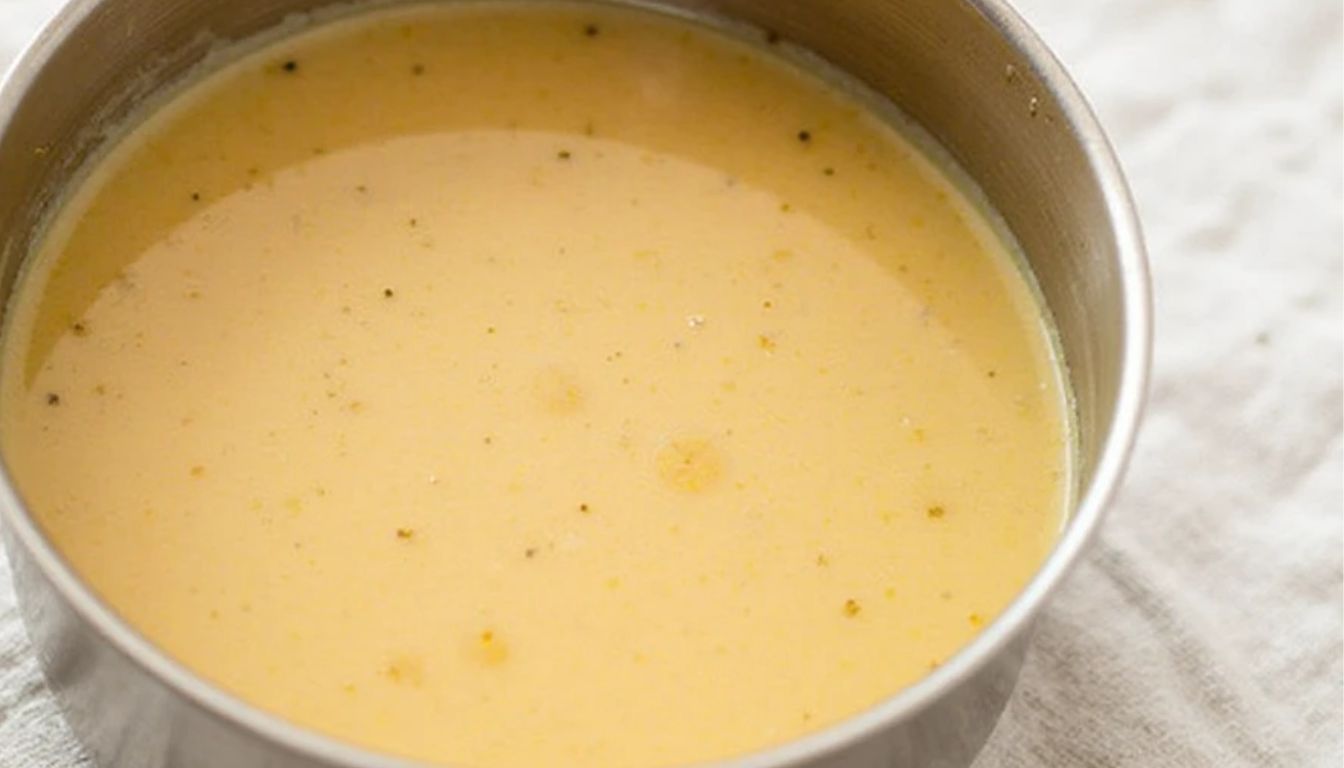Watching my grandmother make chicken gravy was magical. The steam and rich smells filled the kitchen. It showed me cooking is more than food; it’s about love and connection.
Making homemade chicken gravy is more than just a sauce. It’s about bringing comfort to your table. With just 15 minutes and a few ingredients, you can make any meal special.
Starting your homemade chicken gravy journey is easy. This recipe will help you make a smooth, tasty sauce. It’s perfect for both new cooks and kitchen experts.
Table of Contents
Understanding the Magic of Homemade Chicken Gravy

Chicken gravy is more than a simple sauce. It’s a culinary magic that turns ordinary meals into unforgettable dining experiences. Whether you’re making an easy chicken gravy or a creamy one, this versatile condiment adds rich, deep flavors to your dishes.
What Makes Chicken Gravy Special
Homemade gravy is different from store-bought versions in many ways. It has unmatched freshness and flavor when made from scratch. Your kitchen will fill with an irresistible aroma, promising a delicious meal.
- Fresh, natural ingredients
- Complete control over seasoning
- Richer taste profile
- No preservatives or artificial additives
Essential Components of Perfect Gravy
To make the perfect easy chicken gravy, you need to know a few key elements. The right mix of fat, flour, and liquid is what makes your gravy’s texture and flavor.
| Component | Purpose | Recommended Quantity |
|---|---|---|
| Fat (Butter/Drippings) | Creates smooth base | 2-3 tablespoons |
| Flour | Thickening agent | 2-3 tablespoons |
| Liquid (Broth/Stock) | Adds flavor and consistency | 1-2 cups |
Benefits of Making Gravy from Scratch
Making creamy chicken gravy at home has many benefits. You control the ingredients, salt, and flavors to match your dish. It’s quick to make, taking less than 10 minutes, and can turn simple meals into restaurant-quality dishes.
Essential Ingredients and Equipment Needed

Making the perfect chicken stock gravy begins with the right ingredients and tools. Your kitchen setup is key to a great homemade chicken gravy with flour.
Let’s look at what you need to make a tasty gravy that will make your meal better:
Key Ingredients for Chicken Gravy
- All-purpose flour – The main thickener for your gravy
- Chicken drippings – Adds rich, deep flavor
- Chicken stock – Gives depth and keeps the gravy liquid
- Salt and pepper – Basic seasonings to boost taste
- Optional herbs like thyme or rosemary for extra flavor
Essential Equipment
- Heavy-bottomed saucepan
- Whisk – Essential for smooth, lump-free gravy
- Measuring cups and spoons
- Gravy separator – Helps remove excess fat
- Fine-mesh strainer (optional)
When picking ingredients for your chicken gravy, quality is important. Fresh, high-quality chicken stock can make a big difference. Choose organic, low-sodium stock for the best taste.
Pro tip: Get a good whisk and mix flour slowly into your liquid to avoid lumps. Being patient is important for a silky-smooth chicken stock gravy that everyone will enjoy.
The Secret to Perfect Chicken Drippings
Learning to make pan drippings gravy is all about collecting and preparing chicken drippings. These liquid treasures are key to a delicious southern style chicken gravy. They can make any meal at home taste amazing.
To get those tasty drippings from a roasted chicken, you need to know a few tricks. Here are some tips to help you get the most flavor:
- Place a shallow pan beneath the chicken to catch every precious drop
- Add liquid to prevent burning and concentrate flavors
- Use low and slow roasting methods
How to Collect and Prepare Drippings
Getting top-notch drippings takes some care. Take the chicken out of the pan slowly, tilting it to let all juices flow. Let the pan sit for a bit, so fat and liquid can separate on their own.
Maximizing Flavor from Your Roast Chicken
To make your pan drippings gravy even better, try these tips:
- Season the chicken well before roasting
- Put aromatic veggies in the roasting pan
- Deglaze the pan with wine or stock
Using a Gravy Separator Effectively
A gravy separator is a game-changer for smooth, rich chicken gravy. It makes separating fat from liquid easy, so your gravy is always perfect.
Pro tip: Chill the drippings first to make fat separation easier. Pour slowly and watch as the fat floats to the top. This way, you can get rid of excess grease and keep the best parts of your drippings.
Basic Chicken Gravy Recipe
Making an easy chicken gravy recipe is easier than you think. You just need a few ingredients and some basic steps. This way, you can turn simple drippings into a tasty sauce that makes any meal better.
To start your chicken gravy recipe, you’ll need a few key ingredients:
- 4 tablespoons chicken drippings or butter
- 4 tablespoons all-purpose flour
- 3 cups chicken stock or pan drippings
- Seasonings: salt, pepper, garlic powder
The secret to a smooth chicken gravy is the roux technique. Start by melting your fat in a skillet over medium heat. Then, whisk in the flour slowly, making a paste. This paste will thicken your gravy and prevent lumps.
Slowly add your liquid while whisking constantly. This helps your gravy stay smooth. Add your favorite herbs and spices to taste. Let it simmer for 5-7 minutes until it’s just right.
Pro tip: If your gravy is too thick, add more stock. For a thinner gravy, cook it longer to reduce the liquid. Your homemade chicken gravy will be rich and flavorful, much better than store-bought.
Mastering the Roux Technique
Creating the perfect homemade chicken gravy starts with understanding the roux technique. The roux is the secret foundation that turns simple chicken drippings into a luxurious, thick gravy. It uses flour and fat.
The roux is like a magic wand for making chicken gravy with flour. Professional chefs say mastering this technique can make your gravy go from good to extraordinary.
Creating the Perfect Flour-Fat Ratio
Achieving the ideal roux requires precision and understanding. The classic ratio is simple:
- Equal parts fat (butter or chicken drippings)
- Equal parts all-purpose flour
- Whisk continuously to prevent lumps
Common Roux Mistakes to Avoid
Inexperienced cooks often make critical errors when preparing their roux. Here are key pitfalls to watch:
- Cooking at too high a temperature
- Not whisking consistently
- Burning the flour mixture
Timing and Temperature Control
Temperature and timing are key in roux preparation. Different cooking times create varied results:
| Roux Color | Cooking Time | Flavor Profile |
|---|---|---|
| White Roux | 2-3 minutes | Mild, thickening focus |
| Blonde Roux | 5-6 minutes | Nutty, light flavor |
| Brown Roux | 10-15 minutes | Rich, deep taste |
With practice, you’ll develop the skills to create a perfect roux. This will transform your homemade chicken gravy into a restaurant-quality experience.
Troubleshooting Your Chicken Gravy Recipe
Making the perfect chicken gravy can be tricky. Even experienced cooks face challenges. But, most gravy problems have simple fixes that can save your gravy in minutes.
Common Gravy Challenges and Quick Fixes
- Lumpy Gravy:
- Whisk vigorously to break up clumps
- Strain through a fine-mesh sieve
- Use an immersion blender to smooth out texture
- Thin Gravy:
- Simmer to reduce and thicken
- Create a cornstarch slurry
- Add a small amount of flour mixture
- Overly Thick Gravy:
- Gradually whisk in warm chicken stock
- Add small amounts of liquid until desired consistency is reached
Adjusting flavors is key for a great chicken gravy. If it’s too salty, add cream or unsalted stock. For bland gravy, add fresh herbs, black pepper, or white wine.
To avoid separation, keep the temperature steady and whisk constantly. If your gravy breaks, cool it down and whisk in cold butter to fix it.
Remember, the more you practice, the better you’ll get at making chicken gravy. Each try will help you improve, making a sauce that will wow your family and friends.
Flavor Variations and Enhancements
Take your southern style chicken gravy to the next level with creative flavors and smart ingredient choices. The right herbs, spices, and liquids can turn a simple gravy into a standout dish.
Herb and Seasoning Transformations
Adding herbs and spices can make a big difference in your creamy chicken gravy. Here are some great options:
- Fresh thyme for earthy undertones
- Sage for a warm, traditional taste
- Rosemary for aromatic complexity
- Smoked paprika for subtle depth
- White pepper for gentle heat
Wine and Stock Enhancements
Adding liquids can really boost your gravy’s flavor. Try these upgrades:
| Liquid Addition | Flavor Profile | Best Used With |
|---|---|---|
| Dry White Wine | Crisp, acidic | Roasted chicken |
| Sherry | Rich, nutty | Thanksgiving turkey |
| Bone Broth | Deep, savory | Comfort food dishes |
Creating Rich, Deep Flavors
Professional chefs layer flavors for an amazing gravy. Roast garlic, caramelize onions, or use fond for a rich, southern style chicken gravy. It will wow anyone.
Storage and Reheating Guidelines
Keeping your homemade chicken gravy fresh is key. You can enjoy it for days or weeks with the right storage and reheating. Follow these tips to keep your gravy perfect.
Here’s how to store your homemade chicken gravy:
- Cool the gravy completely before storing
- Use airtight containers with tight-fitting lids
- Refrigerate for up to 4 days
- Freeze for extended storage up to 4-6 months
Storing in the fridge is easy. Just put the cooled gravy in a clean container and seal it well. Keep it in the coldest part of your fridge, like the back shelf. Pro tip: Label the container with the date of preparation to track freshness.
To freeze, use containers or bags made for the freezer. Make sure to leave some space at the top. This is because liquids expand when they freeze. When you want to use it, thaw it in the fridge overnight.
Reheating needs to be gentle to keep the gravy smooth. Here’s how to do it:
- Reheat on low heat to prevent separation
- Stir frequently to ensure even warming
- Add a splash of broth if the gravy seems too thick
- Discard if you notice any unusual smell or mold
Always check the gravy’s consistency and flavor before serving. A quick whisk can fix it if it’s not smooth after refrigeration or freezing.
Pairing Suggestions for Your Gravy
Southern style chicken gravy is a versatile culinary treasure. It can turn ordinary meals into extraordinary dining experiences. Whether you’re preparing a hearty breakfast or looking to elevate your dinner, chicken gravy for biscuits offers endless possibilities for delicious combinations.
Discover the ultimate pairings that will make your homemade gravy shine:
- Classic Roasted Dishes
- Roast chicken
- Turkey
- Fried chicken
- Comfort Food Favorites
- Mashed potatoes
- Biscuits
- Rice
- Unexpected Culinary Creations
- Pasta dishes
- Vegetable medleys
- Meat loaf
Your southern style chicken gravy can be a game-changer in the kitchen. Pro tip: Try drizzling it over freshly baked biscuits for a truly indulgent breakfast experience.
| Dish Category | Recommended Gravy Pairing | Flavor Profile |
|---|---|---|
| Breakfast | Buttermilk Biscuits | Rich and Comforting |
| Lunch | Fried Chicken | Savory and Hearty |
| Dinner | Roasted Chicken | Deep and Satisfying |
Experiment with your chicken gravy for biscuits and watch as it becomes the star of your meal. Each spoonful brings warmth, flavor, and a touch of southern hospitality to your table.
Tips for Achieving Restaurant-Quality Results
Making creamy chicken gravy at home is easy. Professional chefs share their secrets to make your gravy amazing. With a few tips, you can make your gravy as good as a restaurant’s.
Professional chefs know that great gravy comes from technique and detail. Here are some insider tips to make your homemade chicken gravy the best.
Professional Chef Secrets
Top chefs share their favorite ways to make great gravy:
- Use a beurre manié (kneaded butter and flour mixture) to thicken gravy smoothly
- Strain your gravy through a fine-mesh sieve for ultimate silkiness
- Build layers of flavor by deglazing the pan with wine or stock
- Taste and adjust seasonings gradually
Texture and Consistency Control
Getting the right texture in your creamy chicken gravy is key. Here are some techniques to master:
- Whisk constantly to prevent lumps
- Cook the roux until it reaches a golden color
- Adjust liquid slowly to control thickness
- Use room temperature ingredients for smoother integration
By using these professional techniques, you’ll make your homemade chicken gravy amazing. It will impress your family and friends, making it taste like it’s from a restaurant.
Alternative Dietary Modifications
Making easy chicken gravy for different diets doesn’t mean losing flavor. You can enjoy a tasty homemade gravy even if you’re gluten-free, dairy-sensitive, or on a specific diet.
Gluten-Free Gravy Options
If you avoid wheat, there are many ways to make a smooth chicken stock gravy:
- Cornstarch as a flour replacement
- Rice flour for a light thickening agent
- Gluten-free flour blends designed for cooking
Dairy-Free Adaptations
Even without dairy, you can make an amazing gravy. Swap butter with:
- Olive oil
- Coconut oil
- Vegetable shortening
Low-Fat and Vegetarian Alternatives
For a lighter gravy, try these changes:
- Use low-sodium chicken broth
- Skip the fat drippings
- Replace chicken stock with vegetable broth for a vegetarian option
Try different methods and ingredients to create your ideal gravy. It should fit your dietary needs and taste great.
Conclusion
Making the perfect chicken gravy is like turning a simple meal into a special event. Your homemade gravy can make roasted poultry and mashed potatoes taste like they’re from a fancy restaurant. You’ll learn how to make a sauce that’s rich, smooth, and all your own.
Homemade chicken gravy is very versatile. By learning how to collect drippings, make a perfect roux, and play with seasonings, you’ll get better at making sauce. Each time you make gravy, you can try new things and make it your own.
Remember, making great chicken gravy takes practice. Even if your first tries don’t turn out right, don’t give up. Every good cook has had their share of kitchen failures. The important thing is to keep trying, tasting, and getting better. Your homemade gravy will get better and better, becoming a favorite in your family.
Now it’s your turn to start making your own chicken gravy. Get your whisk ready, pick out your ingredients, and dive into the world of homemade chicken gravy. Your taste buds and dinner guests will love what you make.
Tried Our Recipe Yet?
There are no reviews yet. Be the first one to write one.

